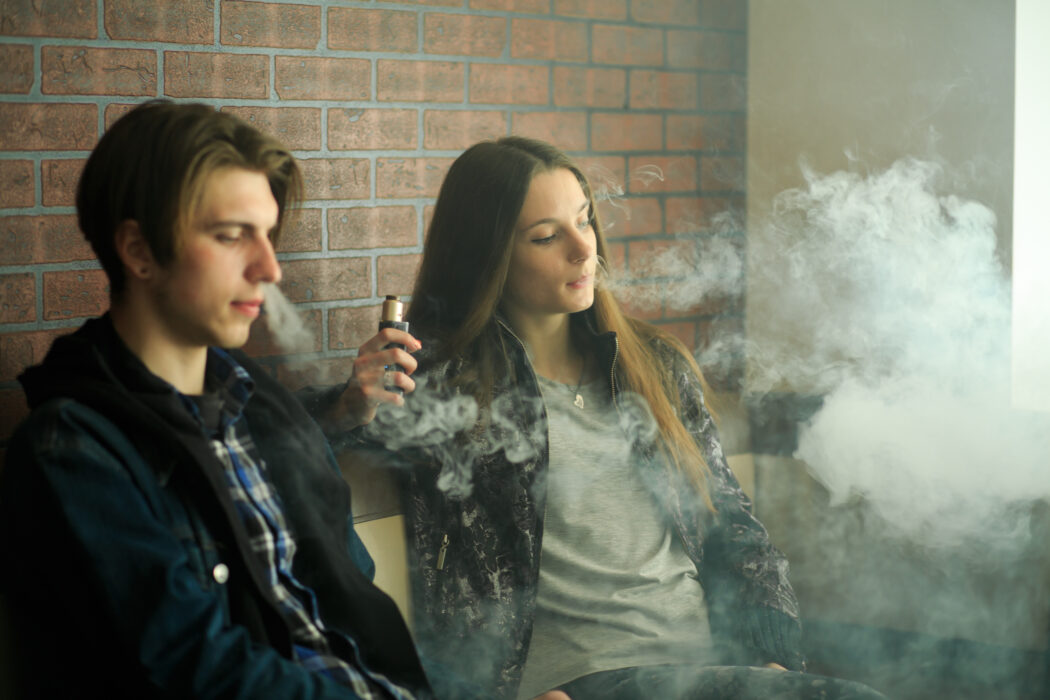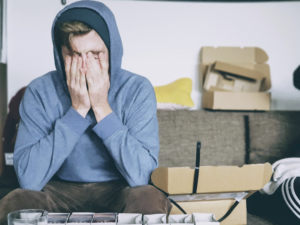Vape use has increased among young people. But while vaping may be considered less dangerous than cigarette smoking, it is not harmless.
In 2018, the global vaping market was valued at just over AUD$19.5 billion. It is expected that, by 2022, it will have grown to over AUD$40 billion.
Many companies target young people via social media, marketing vapes, or e-cigarettes, as a safe, socially acceptable way to inhale substances without the stigma that comes with smoking tobacco cigarettes.

It appears the marketing has been successful. The Alcohol and Drug Foundation (ADF) reports that, based on research undertaken by the Australian Institute of Health and Welfare (AIHW) and Cancer Council Victoria, vaping by young people has increased.
48% of secondary school students had not tried tobacco cigarettes before they started vaping.
Cancer Council Victoria’s 2018 study found that 48% of secondary school students had not tried tobacco cigarettes before they started vaping. About 13% of 12- to 17-year-olds had used an e-cigarette at least once. Vape use increased with age, from 4% of 12-year-olds up to 32% of 17-year-olds.

However, studies about the long-term health effects of vaping are few.
The first e-cigarette was developed in the US in 1963. In 2003, the e-cigarette was patented by a Chinese pharmacist as an alternative to tobacco smoking, after his father, a heavy smoker, died of lung cancer. Vapes soon spread to the rest of the world.
It’s called ‘vaping’ because the substance inhaled is the vapor produced by the heating of a liquid – known as e-juice or e-liquid – to boiling point.
E-juice can be made with or without nicotine, a highly addictive stimulant. Usually, e-juice contains flavouring that is attractive to young people. Popular flavours include fruits, lollies, drinks like strawberry milk, coffee and cocktails, and foods such as donuts and desserts.
A 2020 US study found that young people vape because they think it’s cool and less risky than smoking cigarettes.
A 2020 US study found that young people vape because they think it’s cool and less risky than smoking cigarettes. However, the study also found that vaping caused statistically significant increases in heart rate and decreased blood oxygenation after 20 minutes of vape use.

In 2013, NSW Health tested e-liquids and found that, of the samples collected, 70% contained high levels of nicotine even though the label did not state nicotine was an ingredient.
Nicotine exposure during teenage years can negatively affect brain development, which continues until the age of 25. In addition to increasing the risk of future addiction to other drugs, nicotine can negatively impact learning, memory, and attention in young people.
In addition to increasing the risk of future addiction to other drugs, nicotine can negatively impact learning, memory, and attention in young people.
A literature review of online articles published between 2015 and 2019 found that vaping provided enhanced delivery of nicotine and increased the potential for young users to develop nicotine dependence.
The review also found that although e-cigarettes contained less harmful ingredients than regular cigarettes, there was no evidence these ingredients were safe for young people.

These potentially harmful ingredients include propylene glycol, vegetable glycerin or glycerol, and chemicals used to create flavours.
While propylene glycol is commonly added to food, it is also used to make antifreeze and paint solvent. Vegetable glycerin is used widely in pharmaceuticals and cosmetics. However, when heated it has the potential to release potentially harmful aldehydes such as formaldehyde and acrolein, both known carcinogens.
A 2015 study by Harvard University found vape flavouring contained harmful chemicals including diacetyl and its precursor, acetoin.
Inhalation of diacetyl has been shown to cause a decline in lung function and is associated with the development of a condition called bronchiolitis obliterans or ‘popcorn lung’, named after workers at a microwave popcorn factory where diacetyl was used as flavouring developed the condition.
Australia has adopted a cautious approach to vaping and the sale of e-cigarettes and e-juice, where the advertising and promotion of vaping products is illegal.
In all Australian states and territories, it is illegal to sell, possess or use e-liquids containing nicotine unless prescribed by a medical practitioner for an established therapeutic need. However, e-juice containing nicotine could be imported from other countries.
As of 1 October 2021, the Therapeutic Goods Administration (TGA) strengthened regulations around the importation of nicotine-containing vape products. Consumers are now unable to import nicotine vaping products from an overseas supplier without a valid prescription from an Australian doctor.

The TGA cited the increased use of e-cigarettes by young people and the health risks posed by nicotine exposure as the reasons for this change.
For parents, it can be difficult to know whether their child is vaping.
For parents, it can be difficult to know whether their child is vaping. Unlike cigarettes, which have a distinct smell, e-cigarettes are harder to detect. Also, some vaping devices are made to look like regular, household items such as USB drives, pens, and markers.

There are, however, some tell-tale signs to watch out for:
- Fruit or candylike smells.
- Trouble breathing.
- Unexplained cough.
- Mouth sores.
- Increased thirst.
- Nosebleeds.
- Throat clearing.
- Increased irritability and mood swings.
Many young people believe that vaping is safe, and it can be difficult for them to avoid peers that vape or eliminate exposure to social media that glamourises the practice.
The paediatric section of the Journal of the American Medical Association (JAMA) recommends parents talk to their child about vaping and the risk of exposure to harmful chemicals. Parents can share resources the young person can understand.

That advice is echoed by Melbourne’s Royal Children’s Hospital, who suggest parents avoid smoking or vaping around children. It is important to note that in most Australian states and territories it is illegal to vape in cars with children under 16.
Discussing risky behaviours with teens is an important way for parents to keep their children safe.
Discussing risky behaviours with teens is an important way for parents to keep their children safe. E-cigarettes should be included in that discussion. The more it is discussed, the more likely young people are to listen and be educated about the facts regarding vaping.









